Assignment 3 at least 3 paper Prepare a review of literature
Assignment 3 at least 3 paper
Prepare a review of literature about strategic information systems challenges in public sector in the UAE. Choose one department of your choice and discuss in particular the strategies and the shortcomings of achieving these strategies.
Assignment 4 at least 3 paper
Prepare a review of literature about ethical decision making. Choose one organization of your choice and discuss in particular their IT strategies and how these strategies enforce ethics and privacy in application.
Solution
ISSUE 1: EMIRATISATION
(REPUTATIONAL/CONTROLLABLE/UNCONTROLLABLE)
Needs to be ‘productive’, if not, GREs and SOEs will become as bloated and inefficient as the bureaucratic echelons of most Government departments and ipso facto will not be internationally competitive.Challenge To find ‘productive’ employment for UAE nationals in SOES the quasi- and ‘real’ private sector (Emiratisation in Government departments has already happened – administrative and ‘management’ positions anyhow) without rendering extant private sector entities and flagship commercially-run GREs uncompetitive internationally.Best Case The ‘social contract’ is redefined, benefits are fully separated from employment and ever greater numbers of Emiratis seek to engage in more onerous and productive occupations; the cost of recruiting non-nationals becomes more expensive and thus national reservation wage demands are no longer considered prohibitive by much of the private sector.Worst Case Emiratisation does not actually work in the real private sector due to skills sets and/or reservation wage demands; in GREs and SOEs it results in inefficiently run businesses that are not internationally competitive and thus will require ongoing Government subsidisation.Most Likely Emiratisation will be considered by the real private sector as a form of taxation and will be factored into the cost of setting up in the UAE vis-à-vis the region’s other ‘business friendly’ hubs. But gradually and due to ADEC and a renegotiation of the ‘social contract’ Emiratis will increasingly be able and willing to take on productive roles within GREs and SOEs.
ISSUE 2: DEMOGRAPHIC IMBALANCE
(CONTROLLABLE/UNCONTROLLABLE)This is a two-fold issue: as it encompasses (a) decreasing the number of low-skilled non national workers – controllable – and (b) measures to increase the national Total Fertility rates – uncontrollable as little evidence exists that the state can positively influence this to a significant degree.Consult Middle East Policy, 18(4): 25-43Challenge To reduce the ratio of non-nationals to nationals. Presently of a total UAE population of a little more than eight million only c. 900,000 are Emirati citizens.Best Case Systemic introduction of labour-saving technologies reduces the need for such numbers of non-nationals, improved education results in bilingual Emiratis (i.e. Arabic no longer under ‘threat’ from English/Hindi etc.) and nationals maintain current TFR rate of above 3.Worst Case National TFR continues its downward trend levelling off at around 2.1 and dependence on low skilled non-national labour remains at current levels. Nationals increasingly feel marginalised in unspecified ways as a result of the ‘imbalance’ .Most Likely National TFR remain higher than the global average for high-income countries due to improved maternity rights (for citizens at least) and (a) the increased emphasis on labour-saving technologies (b) the gradual removal of the sponsorship system as it currently manifests and (c) the easing off of large scale infrastructure developments results in a net reduction in the number of non-national workers required.
ISSUE 3: SPONSORSHIP SYSTEM
(REPUTATIONAL/CONTROLLABLE)Challenge To alter the incumbent system whereby (and as a tenet of the ‘social contract’) citizens can benefit financially be granting non-nationals work permits – the opportunity cost being the luxuries afforded by having petrol pump attendants and several domestic workers per household will become a thing of the past.Best Case This system that has at times led HRW etc. to consider the UAE to be exploiting South Asian workers etc. becomes a thing of a past, domestic private sector entities invest in technology as opposed to business practices tailored to having access to large pools of unskilled workers.Worst Case The status quo continues, the discord between some sectors of the citizenry and large numbers of non-nationals continues.
Most Likely Gradually the sponsorship system is phased out, at least the cost for nationals to recruit non-nationals – the work permit issuance system – will be made progressively more expensive and thus providing more incentive for businesses to invest in labour-saving technologies.
ISSUE 4: RENEGOTIATING THE ‘SOCIAL CONTRACT’
(CONTROLLABLE)
Presently a key transmission mechanism of the UAE’s ruling bargain is the provision of a well remunerated ‘government job’ for each and every national irrespective of merit.
Consult Middle East Policy, 17(2): 38-51
Challenge To distribute oil wealth to the citizenry in ways that do not act to distort the labour market.
Best Case All associated benefits are detached from (sinecure-type) government jobs, and allocated to nationals via other mechanisms, this will enable the public sector to become more productive and act to normalise private sector employment.Worst Case Due to inter alia socio-cultural sensibilities, tribal characteristics the provision of government jobs for the majority of nationals continues apace; this becomes an ever greater recurrent fiscal burden due to the country’s demographic profile and hinders the strategic vision of transitioning to a knowledge-based economy.
Most Likely Security services aside, more and more nationals will accept undertaking additional vocational courses and positions other than administrative ones in GREs and SOEs; gradually the Government remove the additional benefits attached to ‘government jobs’ and thus make the pull of this sector less stark.
ISSUE 5: ABU DHABI ECONOMIC VISION 2030
(REPUTATIONAL/’CONTROLLABLE’)Challenge To fulfil the aims and objectives set out in the 2008 manifesto, the physical infrastructure is realisable as the Emirate can afford the strategic acquisitions/ investments (off-set program) and recruit the human capital required to put this in place. Therefore the challenge will be to foster/incubate the indigenous human capital required to render this vision sustainable in the longer term,Best Case Within reason the aims and objectives are met and the current generation of nationals residing in Abu Dhabi are suitably skilled and motivated to take part as a result of the systemic educational reforms that are being spearheaded now by ADEC.
Worst Case Not only is the national human capital not in place but many of the flagship projects are either not completed or are but do not meet the expectations of society and business.
Most Likely Most of the key infrastructural projects are in place (and are well received) and, in terms of human capital, a situation somewhere in between the above two.
ISSUE 6: ADEC/MUBADALA
(REPUTATIONAL/’CONTROLLABLE’)Challenge As the key actors that have been set up and tasked to implement the main aspects of the Economic Vision, these entities need to created a motivated, suitably skilled and competitively priced workforce and acquire strategic assets and add-value locally respectively.Best Case ADEC systemically overhauls the Emirate’s education system and this is then rolled out across all Emirates. The industries that Mubadala are now investing in are (a) commercially viable and (b) attractive to future generations of Emirati jobseekers. Moreover, the schemes that are now limited to the Emirate of Abu Dhabi – once deemed to be successful are rolled out/replicated in the Northern Emirates.Worst Case (1) The changes that ADEC try to implement are not well received (esp. the focus on English to the ‘detriment’ of Arabic) and do not produce the desired human capital. Mubadala’s investments do not become competitive and remain dependent on Government subsidies (directly or indirectly). (2) The investments in the Emirate of Abu Dhabi are not replicated in the Northern Emirates and result in an increasingly divided Federation in terms of employment prospects and the quality of educational attainment levels.Most Likely To far off to forecast with any degree of credibility.
ISSUE 7: DUPLICITY IN DIVERSIFICATION
(CONTROLLABLE/REPUTATIONAL)While competition within and between Emirates can be construed as positive in terms of driving innovation and competitiveness, in two areas aviation and finance such duplicity between Abu Dhabi and Dubai may be inefficient at the state level.
Challenge How best to merge Emirates/Etihad and DIFC/ Sowwah Island. If this can be achieved the UAE would stand a good chance of becoming the Middle East’s if not the world’s key aviation hub and the MENA region’s de facto financial hub.
Best Case Dubai becomes the leading aviation hub in the world and the (possibly renamed)Mattoon International Airport (which is anyway on the Abu Dhabi board) becomes the home of Emirates-Etihad. Abu Dhabi – home of the Central Bank – and backed by its resource wealth and SWFs – in close proximity to Dubai’s commercial and transport hub (DP World) -becomes the de facto financial hub for the MENA region.
Worst Case Such duplicity continued and grows and ultimately wastes the financial resources of both Emirates and potential synergies are not realised.
Most Likely Hard to say, but AD may become the financial hub irrespective of a merger between the two Emirates stock markets and there is constant talk of Dubai relinquishing some degree of control over Emirates airline in return for assistance with debt repayments.
ISSUE 8: (NON-NATIONAL) REALESTATE OWNERSHIP
(CONTROLLABLE/REPUTATIONAL)Challenge To legislate UAE-wide binding and unambiguous legislation on property ownership rights for non-nationals (all cohorts), in order to re-establish investor confidence.Best Case A unified property ownership-law is put into law and is deemed as credible by all classes of international investor.Worst Case The discord resultant from Hydra Properties etc. etc. is repeated and the UAE is never able to attract second-home owners as it was prior to 2007, and will only be capable of temporarily attracting speculators and war-refugees.Most Likely Due to the seemingly perpetual regional instability a great many people will continue to want to own a property in the UAE – even if ambiguities remain – such buyers will mostly be from other Arab states and South Asia, not Europe and the US.
ISSUE 9: TOURISM
A sustainable source of non-oil income – exemplified by ‘Visit Abu Dhabi – travellers Welcome; Dubai’s malls and Fujairah’s beaches – but one that necessitates the provision of alcohol and nightclubs etc.
Challenge To find a balance between on the one hand attracting more tourists and on the other minimising the – real or perceived – costs such tourists are considered by some sectors of the local population to have on the country’s socio-cultural fabric. (The inter-Emirate competition in this sector can be considered as a positive.)Best Case The UAE continues its rise as an internationally recognised tourist attraction. Will be augmented once all of the planed attractions on Sadayat Island are completed. (Tourist numbers could be substantially boosted if either of the two national airlines were to offer subsidies short-stay stopovers for the many transit passengers.)Worst Case The developments planned for Sadayat Island do not come to fruition the novelty of Dubai wares off – a distinct possibility if the non-mall components of ‘Dubailand’ are not at some point actual implemented.Most Likely Barring any unforeseen and sustained terrorist attacks targeting tourists; the best case scenario.
ISSUE 10: HYDROCARBON DEPLEATION
Challenge To ensure that prior to the depletion of commercially extractable oil and gas, the UAE is able to sustainably maintain the current living standards experienced by Emiratis. (This is a challenge that may not need to be faced for several generations.)Best Case The Abu Dhabi Economic Vision 2030 is successfully realised and is subsequently duplicated in the Northern Emirates. ADIA et al. Accumulate enough resources so that this sovereign wealth can act as a sustainable substitute for the current oil-rent.Worst Case The current levels of living standards are considerably reduced.Most Likely To far off to forecast with any degree of credibility.
ISSUE 11: RESOURCE DEPLETION:Challenge To ensure that water shortages are avoided.Best Case The country’s water and electricity requirements are able to be met by way of Abu Dhabi’s nuclear power program, which may need to be expanded for that which is currently going to be constructed.Worst Case The Northern Emirates suffer from more electricity and water cuts and this becomes a key bone of contention for FNC members from these Emirates.Most Likely Abu Dhabi’s nuclear program is capable of providing enough energy for desalination to provide enough water, but current excesses/luxuries (e.g., European grass lawns) are less common and are priced at non-subsidised rates.
ISSUE 12: UTILITY SUBSIDIES:Consider the recent case of Dubai no longer being willing to subsidise the petrol pumps of the Northern Emirates and Abu Dhabi’s Emirat (ADNOC) having to step in.Challenge To reduce the amount of petrol, water and electricity that is needlessly consumed, in no small part due to the extent to which such products are subsidised.Best Case Nationals and non-nationals are to pay for such utilities at non-subsidies prices .Worst Case The status quo is maintained.Most Likely The degree to which non-nationals have such utilities subsidised is gradually cut until they pay the actual cost price, after which more and more nationals are to pay cost price for such utilities over and above a free allowance for what is considered sensible usage levels.
ISSUE 13: IMPLICATIONS OF A WESTERN ATTACK ON IRAN:Dubai is – if only for commercial reasons – a lot closer to Iran than is Abu Dhabi, this divergence is likely to keep the UAE away from being the West’s regional ally in any pre-emptive action targeted at Iran.Challenge To seek to mitigate against any negative consequences of Western (read Israeli-led) aggression towards Iran be it security costs, loss of international investor confidence, reduction in numbers of tourists.Best Case The UAE officially opposes any attack and does not in any way facilitate such actions (as might other Gulf states due to the US military assists housed there), and benefits as it indirectly did from the wars in Afghanistan and Iraq as many wealth Iranians seek shelter in the UAE for themselves and their capital.Worst Case If the long-run dispute over the three islands of Greater and Lesser Tunb and Abu Musa becomes part of the case against Iran, and the UAE in some practical way aides an attack on Iran; Western interests in the UAE could conceivably become targets for Iranian retaliatory actions. Most Likely Any attack on Iran is limited and is seen by Iran for what it most probably will be, an Israeli-led and motivated targeted attack and therefore, the UAE will not be blamed and thus be subjected to actual Iranian retribution; the UAE will continue to benefit as a conduit for investment of Iranian oil wealth.
ISSUE 14: INTERNAL DISSENT:This is mentioned as other analysts may raise this as a challenge/issue going forward, but I do not see this as likely in terms of it posing a serious socio-political threat. This holds for both national and non-national cohorts. Disenfranchisement and dissatisfaction with rights etc. respectively are not forecast to lead to any serious threats.
ISSUE 15: DUBAI’S DEBT :This is mentioned as other analysts may raise this as a challenge/issue going forward, but I do not see this as likely. Abu Dhabi and ADIA can more than cover/underwrite the debt and are unlikely to wait to the 11th hour again to ‘bail out’ Dubai as this backfired to an extent on Abu Dhabi’s own credibility.
Simply stated, ethics refers to standards of behavior that tell us how human beings ought to act in the many situations in which they find themselves-as friends, parents, children, citizens, businesspeople, teachers, professionals, and so on.
It is helpful to identify what ethics is NOT:
Ethics is not the same as feelings. Feelings provide important information for our ethical choices. Some people have highly developed habits that make them feel bad when they do something wrong, but many people feel good even though they are doing something wrong. And often our feelings will tell us it is uncomfortable to do the right thing if it is hard.
Ethics is not religion. Many people are not religious, but ethics applies to everyone. Most religions do advocate high ethical standards but sometimes do not address all the types of problems we face.
Ethics is not following the law. A good system of law does incorporate many ethical standards, but law can deviate from what is ethical. Law can become ethically corrupt, as some totalitarian regimes have made it. Law can be a function of power alone and designed to serve the interests of narrow groups. Law may have a difficult time designing or enforcing standards in some important areas, and may be slow to address new problems.
Ethics is not following culturally accepted norms. Some cultures are quite ethical, but others become corrupt -or blind to certain ethical concerns (as the United States was to slavery before the Civil War). \"When in Rome, do as the Romans do\" is not a satisfactory ethical standard.
Ethics is not science. Social and natural science can provide important data to help us make better ethical choices. But science alone does not tell us what we ought to do. Science may provide an explanation for what humans are like. But ethics provides reasons for how humans ought to act. And just because something is scientifically or technologically possible, it may not be ethical to do it.
Why Identifying Ethical Standards is Hard
There are two fundamental problems in identifying the ethical standards we are to follow:
On what do we base our ethical standards?
How do those standards get applied to specific situations we face?
If our ethics are not based on feelings, religion, law, accepted social practice, or science, what are they based on? Many philosophers and ethicists have helped us answer this critical question. They have suggested at least five different sources of ethical standards we should use.
Five Sources of Ethical Standards
The Utilitarian Approach
Some ethicists emphasize that the ethical action is the one that provides the most good or does the least harm, or, to put it another way, produces the greatest balance of good over harm. The ethical corporate action, then, is the one that produces the greatest good and does the least harm for all who are affected-customers, employees, shareholders, the community, and the environment. Ethical warfare balances the good achieved in ending terrorism with the harm done to all parties through death, injuries, and destruction. The utilitarian approach deals with consequences; it tries both to increase the good done and to reduce the harm done.
The Rights Approach
Other philosophers and ethicists suggest that the ethical action is the one that best protects and respects the moral rights of those affected. This approach starts from the belief that humans have a dignity based on their human nature per se or on their ability to choose freely what they do with their lives. On the basis of such dignity, they have a right to be treated as ends and not merely as means to other ends. The list of moral rights -including the rights to make one\'s own choices about what kind of life to lead, to be told the truth, not to be injured, to a degree of privacy, and so on-is widely debated; some now argue that non-humans have rights, too. Also, it is often said that rights imply duties-in particular, the duty to respect others\' rights.
The Fairness or Justice Approach
Aristotle and other Greek philosophers have contributed the idea that all equals should be treated equally. Today we use this idea to say that ethical actions treat all human beings equally-or if unequally, then fairly based on some standard that is defensible. We pay people more based on their harder work or the greater amount that they contribute to an organization, and say that is fair. But there is a debate over CEO salaries that are hundreds of times larger than the pay of others; many ask whether the huge disparity is based on a defensible standard or whether it is the result of an imbalance of power and hence is unfair.The Common Good Approach
The Greek philosophers have also contributed the notion that life in community is a good in itself and our actions should contribute to that life. This approach suggests that the interlocking relationships of society are the basis of ethical reasoning and that respect and compassion for all others-especially the vulnerable-are requirements of such reasoning. This approach also calls attention to the common conditions that are important to the welfare of everyone. This may be a system of laws, effective police and fire departments, health care, a public educational system, or even public recreational areas.
The Virtue Approach
A very ancient approach to ethics is that ethical actions ought to be consistent with certain ideal virtues that provide for the full development of our humanity. These virtues are dispositions and habits that enable us to act according to the highest potential of our character and on behalf of values like truth and beauty. Honesty, courage, compassion, generosity, tolerance, love, fidelity, integrity, fairness, self-control, and prudence are all examples of virtues. Virtue ethics asks of any action, \"What kind of person will I become if I do this?\" or \"Is this action consistent with my acting at my best?\"
Putting the Approaches Together
Each of the approaches helps us determine what standards of behavior can be considered ethical. There are still problems to be solved, however.
The first problem is that we may not agree on the content of some of these specific approaches. We may not all agree to the same set of human and civil rights.
We may not agree on what constitutes the common good. We may not even agree on what is a good and what is a harm.
The second problem is that the different approaches may not all answer the question \"What is ethical?\" in the same way. Nonetheless, each approach gives us important information with which to determine what is ethical in a particular circumstance. And much more often than not, the different approaches do lead to similar answers.Making DecisionsMaking good ethical decisions requires a trained sensitivity to ethical issues and a practiced method for exploring the ethical aspects of a decision and weighing the considerations that should impact our choice of a course of action. Having a method for ethical decision making is absolutely essential. When practiced regularly, the method becomes so familiar that we work through it automatically without consulting the specific steps.
The more novel and difficult the ethical choice we face, the more we need to rely on discussion and dialogue with others about the dilemma. Only by careful exploration of the problem, aided by the insights and different perspectives of others, can we make good ethical choices in such situations.
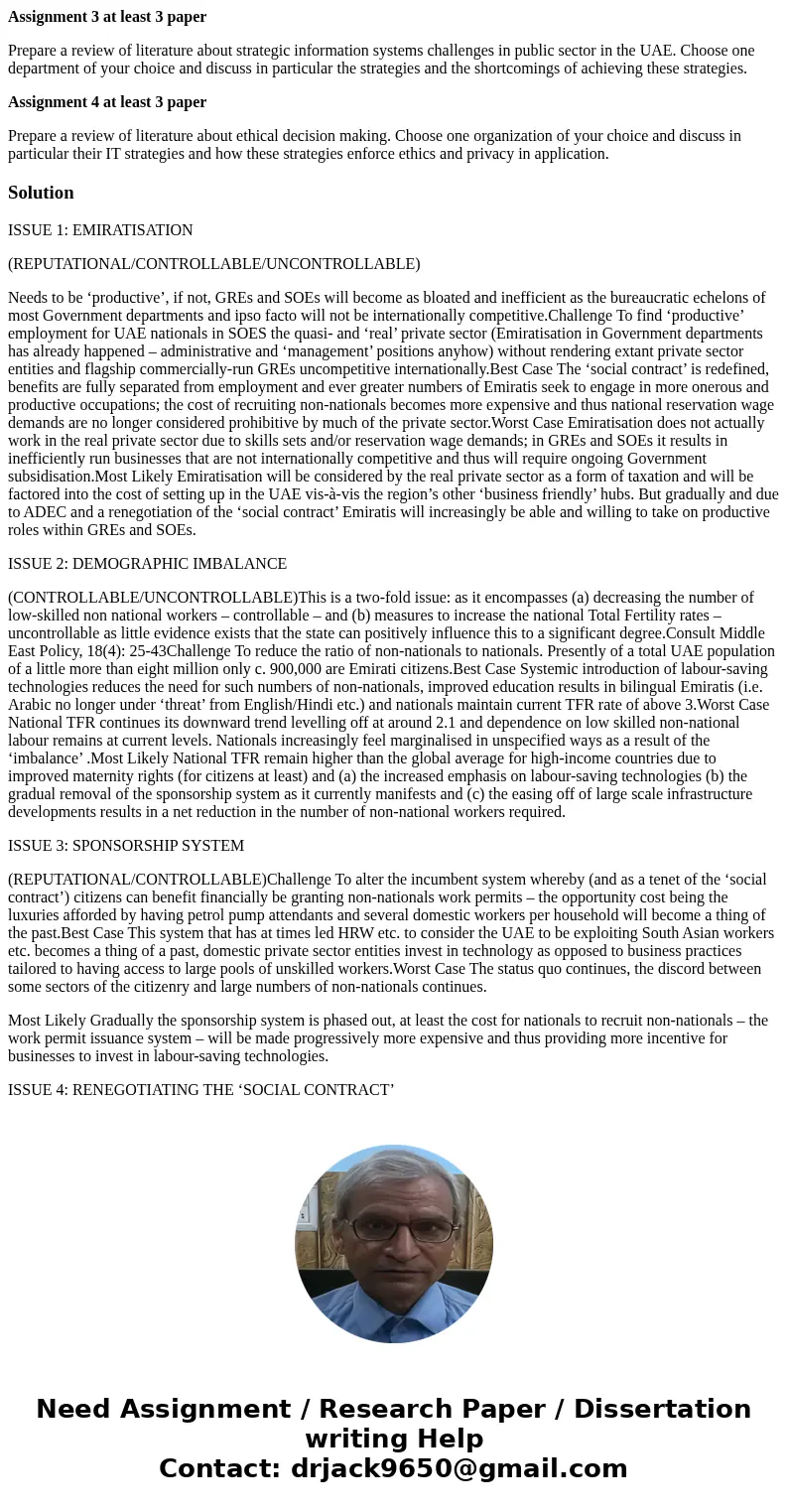
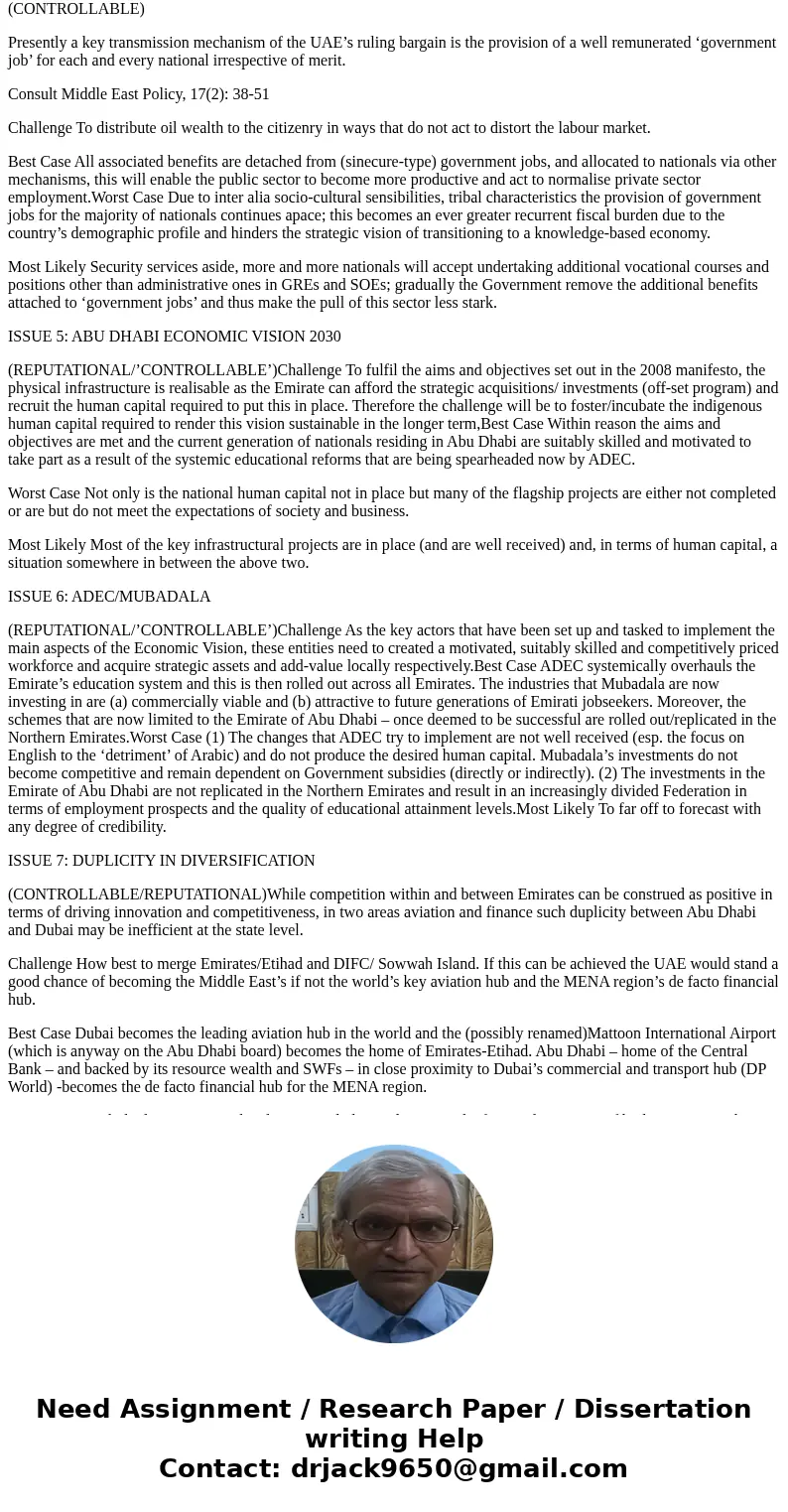
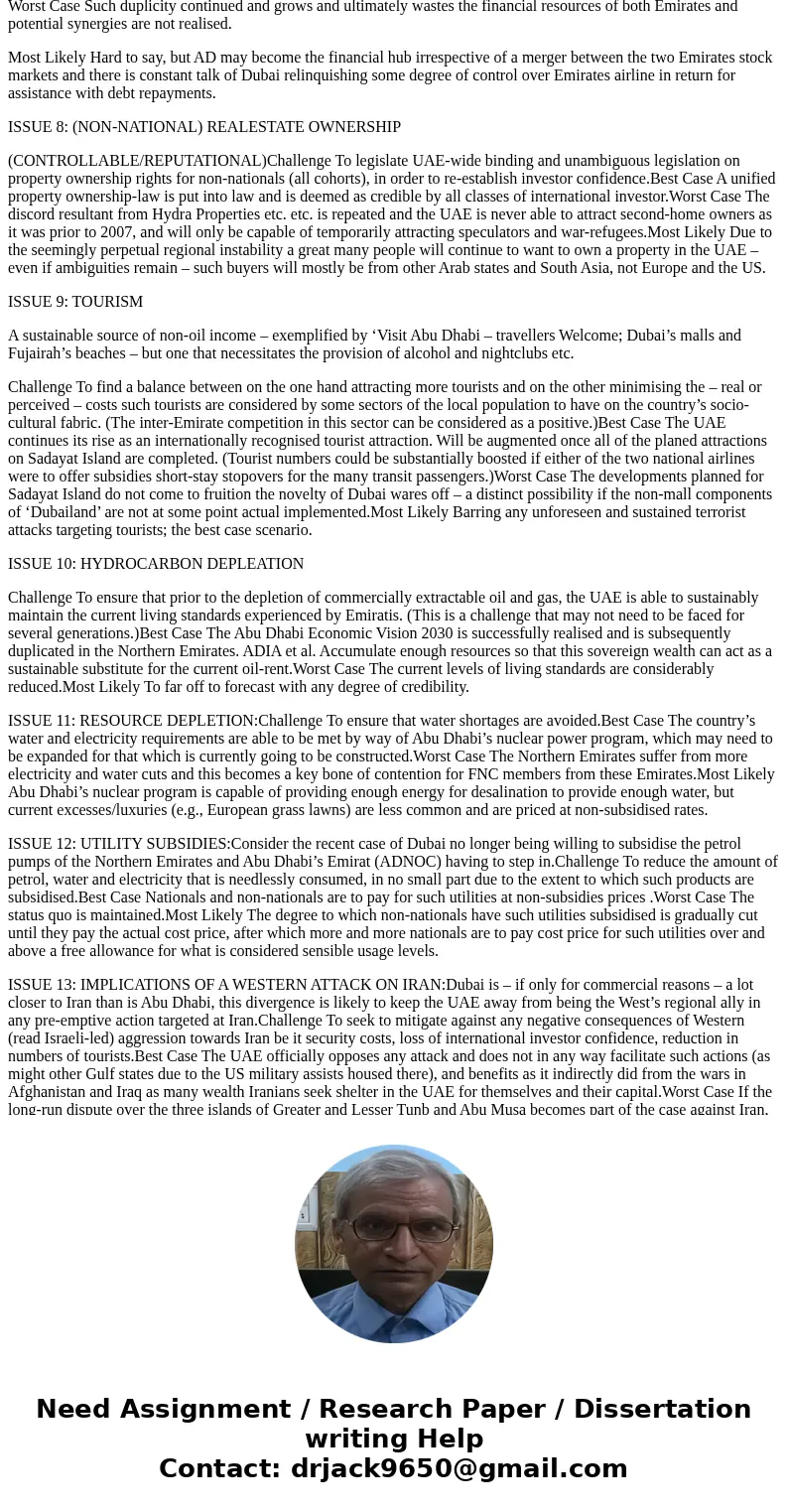
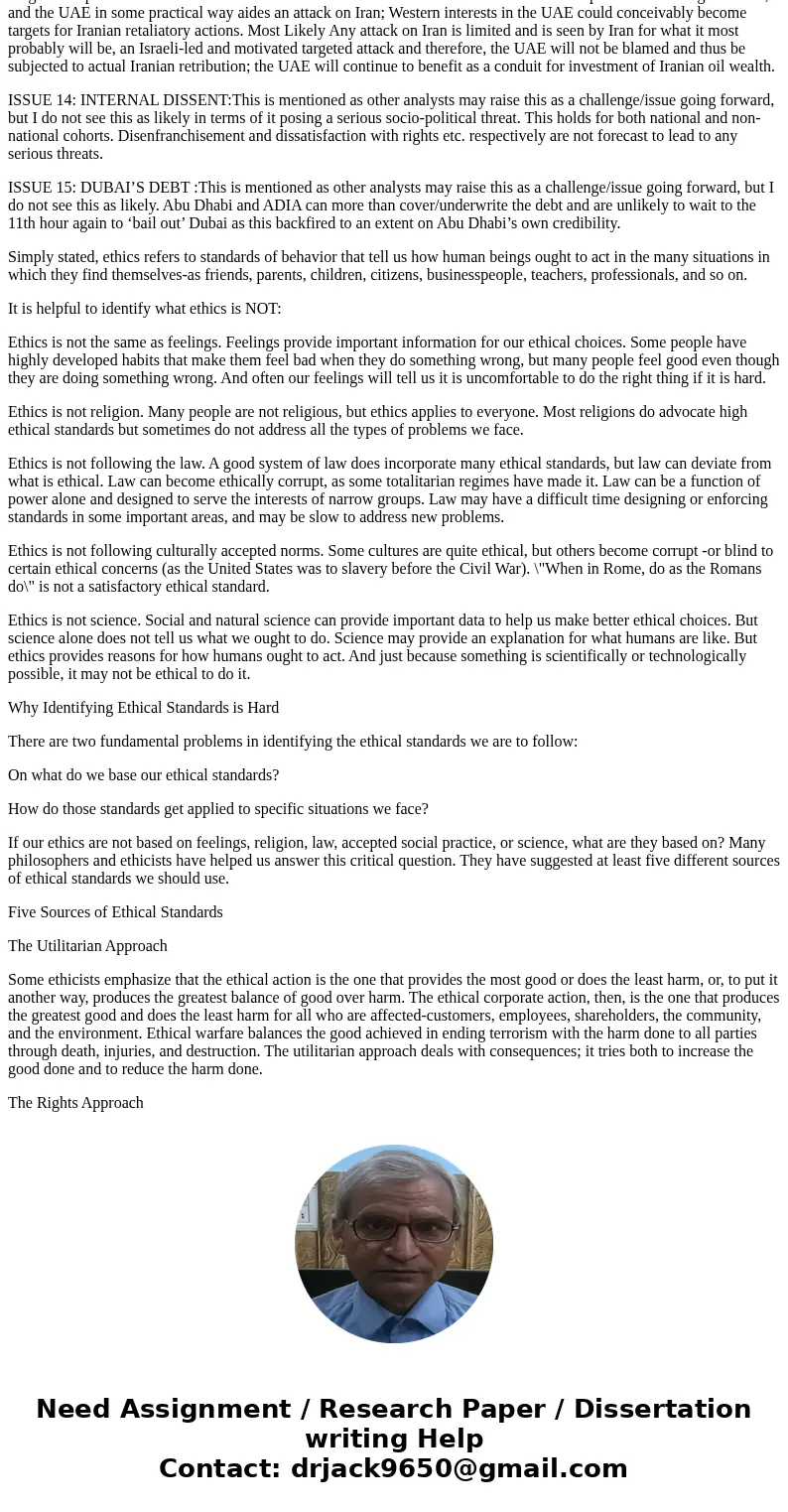
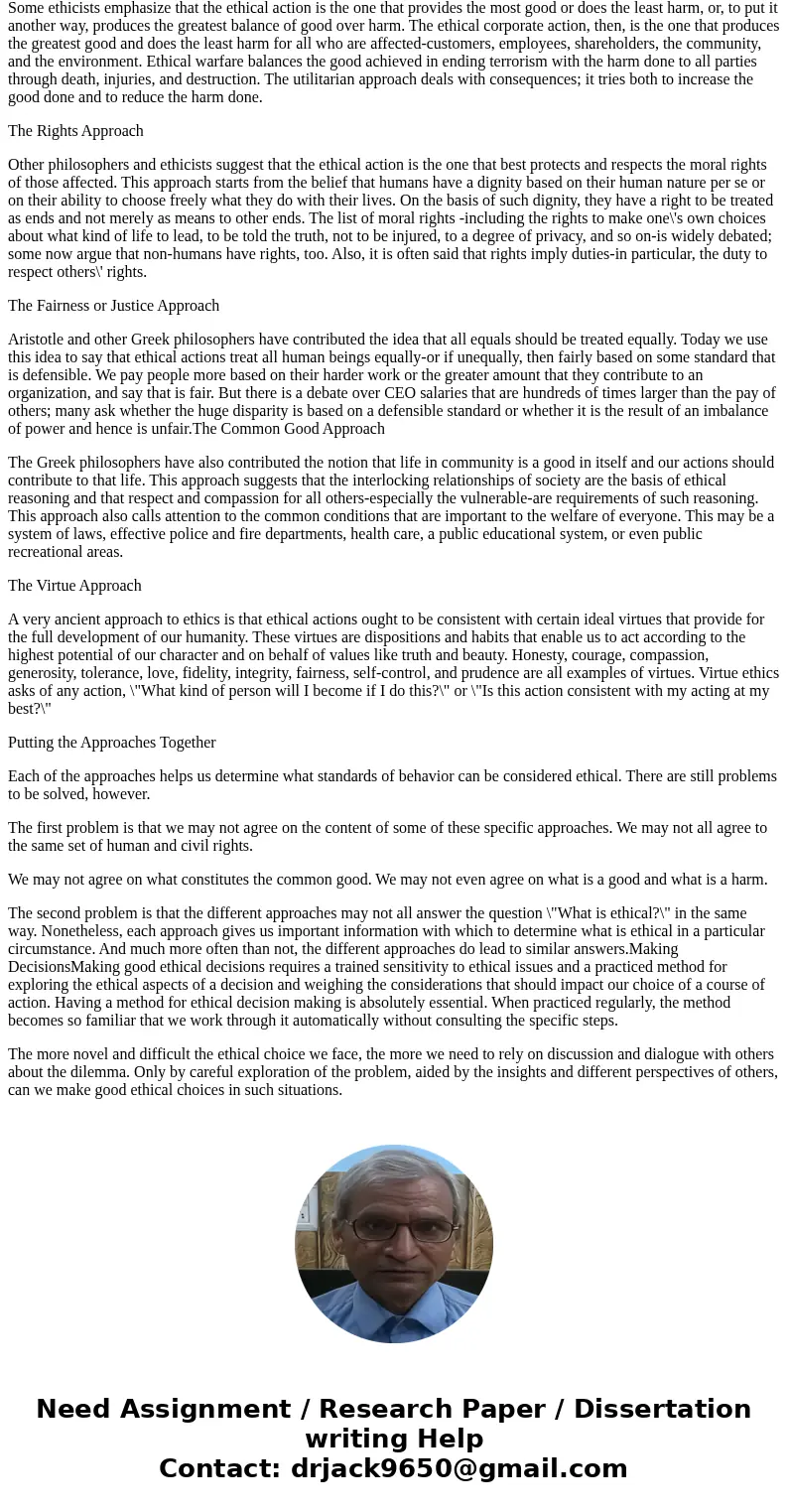
 Homework Sourse
Homework Sourse